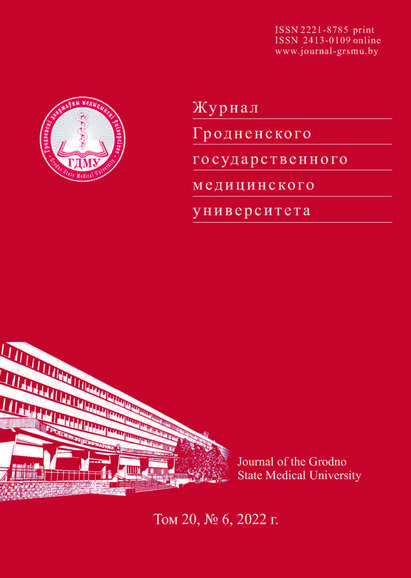ОСОБЕННОСТИ ЛОКАЛЬНОГО ИММУННОГО ОТВЕТА И ИММУНОГИСТОХИМИЧЕСКИЕ МАРКЕРЫ ПРОГНОЗА ПРИ РАКЕ ШЕЙКИ МАТКИ

Аннотация
Согласно современным данным, рак шейки матки (РШМ) занимает одно из ведущих мест в структуре злокачественных новообразований у женщин Республики Беларусь и Российской Федерации, а также является четвертым по распространенности видом рака среди женщин во всем мире и седьмым в общей статистике встречаемости злокачественных опухолей человека. В настоящее время отмечается тенденция к повышению частоты РШМ среди женщин молодого возраста, в связи с чем проблема диагностики и оценки прогноза данной опухолевой патологии все более актуальна. Процесс канцерогенеза в шейке матки имеет сложную мультифакториальную природу и включает множество биохимических механизмов. Для их оценки используются разные иммуногистохимические маркеры. С целью определения биологического потенциала плоскоклеточного рака шейки матки исследователями оценивалась роль экспрессии белков p53, Ki67, циклина D1 и CD45, предполагалось также применение этих маркеров в качестве инструмента ранней диагностики рака. Однако данных о роли местного иммунитета в оценке инвазивного и метастатического потенциала злокачественного новообразования все еще крайне мало. В статье приведены современные литературные данные о прогностической роли экспрессии иммуногистохимических маркеров при РШМ и особенностях местного иммунитета при цервикальных неоплазиях.
Литература
World Cancer Research Fund International. Cervical cancer statistics [Internet]. Available from: https://www.wcrf.org/cancer-trends/cervical-cancer-statistics.
Shiman O, Basinsky V. Kliniko-morfologicheskij analiz invazivnogo ploskokletochnogo raka shejki matki v Grodnenskoj oblasti za 2006-2013 gody. In: Snezhitskiy VA, ed. Aktualnye problemy mediciny [Internet]. Sbornik materialov itogovoj nauchno-prakticheskoj konferencii; 2020 Jan 24. Grodno: GrSMU; 2020. p. 798-801. Available from: http://elib.grsmu.by/handle/files/16434. (Russian).
Longatto-Filho A, Fregnani JH, Mafra da Costa A, de Araujo-Souza PS, Scapulatempo-Neto C, Herbster S, Boccardo E, Termini L. Evaluation of Elafin Immunohistochemical Expression as Marker of Cervical Cancer Severity. Acta Cytol. 2021;65(2):165-174. https://doi.org/10.1159/000512010.
Prilepskaja VN, Rogovskaja SI. Novye tehnologii profilaktiki raka shejki matki. In: Prilepskaja VN, ed. Patologija shejki matki i genitalnaja infekcija. Moscow: MEDpress-inform; 2008. p. 8-15. (Russian).
Minkina GN, Manuhin IB. Proliferativnaja aktivnost jepitelija pri ploskokletochnyh jepitelialnyh porazhenijah shejki matki. Zhurnal akusherstva i zhenskih boleznej [Journal of Obstetrics and Women's Diseases]. 2008;50(1):34-36. https://doi.org/10.17816/JOWD88964. (Russian).
Richart RM. Cervical intraepithelial neoplasia. Pathol Annu. 1973;8:301-328.
National Cancer Institute. Low-grade squamous intraepithelial lesion [Internet]. Available from: https://www.cancer.gov/publications/dictionaries/cancer-terms/def/low-grade-squamous-intraepithelial-lesion.
Ma ZY, Zhu YF, Liu ZH, Zhu HY, Li L, Liu AJ. [Expression of PD-L1 and tumor infiltrating lymphocyte markers in uterine cervical carcinoma]. Zhonghua Bing Li Xue Za Zhi. 2022;51(7):602-607. https://doi.org/10.3760/cma.j.cn112151-20220403-00252. (Chinese).
Ding X, Liu Z, Su J, Yan D, Sun W, Zeng Z. Human papillomavirus typespecific prevalence in women referred for colposcopic examination in Beijing. J Med Virol. 2014;86:1937-1943. https://doi.org/10.1002/jmv.24044.
Cardoso FA, Campaner AB, Silva MA. Prognostic value of p16(INK4a) as a marker of clinical evolution in patients with cervical intraepithelial neoplasia grade 3 (CIN 3) treated by cervical conization. APMIS. 2014;122(3):192-199. https://doi.org/10.1111/apm.12130.
Ungureanu C, Teleman S, Socolov D, Anton G, Mihailovici MS. Evaluation of p16INK4a and Ki-67 proteins expression in cervical intraepithelial neoplasia and their correlation with HPV-HR infection. Rev Med Chir Soc Med Nat Iasi. 2010;114 (3):823-828.
Silva DC, Gonçalves AK, Cobucci RN, Mendonça RC, Lima PH, Cavalcanti G Júnior. Immunohistochemical expression of p16, Ki-67 and p53 in cervical lesions – A systematic review. Pathol Res Pract. 2017;213(7):723-729. https://doi.org/10.1016/j.prp.2017.03.003.
Shiman OV. Analiz svjazi immunogistohimicheskogo markera CD45RO s prognozom raka shejki matki. In: Krotkova EN, ed. Sbornik materialov respublikanskoj nauchno-prakticheskoj konferencii studentov i molodyh uchenyh, posvjashhennogo 100-letiju so dnja rozhdenija professora Parameja Vladimira Trofimovicha [Internet]; 2021 Apr 29-20. Grodno: GrSMU; 2021. p. 75-78. Available from: http://elib.grsmu.by/handle/files/24545 (Russian).
Shiman O, Basinsky V. Prognosticheskaja ocenka urovnja jekspressii Cyclin D1 v rake shejki matki [Prognostic evaluation of Cyclin D1 expression level in cervical cancer]. In: Anfinogenova EA, Bich TA, Guzov SA, Davydov DA, Dmitrieva MV, Kiselev PG, Letkovskaja TA, Mohammadi TM, Nedzved MK, Nerovnja AM, Portjanko AS, Savosh VV, Judina OA, eds. Sovremennaja patologicheskaja anatomija: nauchno-prakticheskij opyt, puti sovershenstvovanija i innovacionnye tehnologii morfologicheskoj diagnostiki, rol v klinicheskoj praktike, aktualnye problemy i perspektivy razvitija [Internet]. Sbornik materialov IV sezda patologoanatomov Respubliki Belarus s mezhdunarodnym uchastiem; 2022 Mar 24-25; Minsk. Minsk: BGMU; 2022. p. 410-415. Available from: http://syezd-patologoanatomov-belarus.gobel.by/images/sbornik-tezisov.pdf. (Russian).
Wu J, Li XJ, Zhu W, Liu XP. Detection and pathological value of papillomavirus DNA and p16INK4A and p53 protein expression in cervical intraepithelial neoplasia. Oncol Lett. 2014;7(3):738-744. https://doi.org/10.3892/ol.2014.1791.
Ozaki S, Zen Y, Inoue M. Biomarker expression in cervical intraepithelial neoplasia: potential progression predictive factors for low-grade lesions. Hum Pathol. 2011;42(7):1007-1012. https://doi.org/10.1016/j.humpath.2010.10.021.
Martin CM, O’Lery JJ. Histology of cervical intraepithelial neoplasia and the role of biomarkers. Best Pract. Res. Clin. Obst. Gynaecol. 2011;25(5):605-615. https://doi.org/10.1016/j.bpobgyn.2011.04.005.
Kava S, Rajaram S, Arora VK, Goel N, Aggarwal S, Mehta S. Conventional cytology, visual tests and evaluation of P16INK4A as a biomarker in cervical intraepithelial neoplasia. Indian J Cancer. 2015;52(3):270-275. https://doi.org/10.4103/0019-509X.176729.
Ekalaksananan T, Pientong C, Sriamporn S, Kongyingyoes B, Pengsa P, Kleebkaow P, Kritpetcharat O, Parkin DM. Usefulness of combining testing for p16 protein and human papillomavirus (HPV) in cervical carcinoma screening. Gynecol. Oncol. 2006;103(1):62-66. https://doi.org/10.1016/j.ygyno.2006.01.033.
Rocha AS, Bozzetti MC, Kirschnick LS, Edelweiss MI. Antibody antip16ink4a in cervical cytology. Acta Cytol. 2009;53(3):253-260. https://doi.org/10.1159/000325304.
Murphy N, Ring M, Heffron CC, King B, Killalea AG, Hughes C, Martin CM, McGuinness E, Sheils O, O'Leary JJ. p16INK4A, CDC6, and MCM5: predictive biomarkers in cervical preinvasive neoplasia and cervical cancer. J Clin Pathol. 2005;58(5):525-534. https://doi.org/10.1136/jcp.2004.018895.
Tsoumpou I, Arbyn M, Kyrgiou M, Wentzensen N, Koliopoulos G, Martin-Hirsch P, Paraskevaidis E. p16(INK4a) immunostaining in cytological and histological specimens from theuterine cervix: a systematic review and metaanalysis. Cancer Treat Rev. 2009;35(3):210-220. https://doi.org/10.1016/j.ctrv.2008.10.005.
Samarawardana P, Singh M, Schroyer KR. Dual Stain Immunohistochemical Localization of p16INK4A and ki-67: A Synergistic Approach to Identify Clinically Significant Cervical Mucosal Lesions. Appl Immunohistochem Mol Morphol. 2011;19(6):514-518. https://doi.org/10.1097/PAI.0b013e3182167c66.
Fujii T, Saito M, Hasegawa T, Iwata T, Kuramoto H, Kubushiro K, Ohmura M, Ochiai K, Arai H, Sakamoto M, Motoyama T, Aoki D. Performance of p16INK4a/Ki-67 immunocytochemistry for identifying CIN2+ in atypical squamous cells of undetermined significance and low-grade squamous intraepithelial lesion specimens: a Japanese Gynecologic Oncology Group study. Int J Clin Oncol. 2015;20(1):134-142. https://doi.org/10.1007/s10147-014-0688-0.
Calil LN, Edelweiss MI, Meurer L, Igansi CN, Bozzetti MC. p16INK4a and Ki67 expression in normal, dysplastic and neoplastic uterine cervical epithelium and human papillomavirus (HPV) infection. Pathol Res Pract. 2014;210(8):482-487. https://doi.org/10.1016/j.prp.2014.03.009.
Focchi GR, Silva ID, Nogueira-de-Souza NC, Dobo C, Oshima CT, Stavale JN. Immunohistochemical Expression of p16 (INK4A) in Normal Uterine Cervix, Nonneoplastic Epithelial Lesions, and Low-grade Squamous Intraepithelial Lesions. J Low Genit Tract Dis. 2007;11(2):98-104. https://doi.org/10.1097/01.lgt.0000245042.29847.dd.
Lee J-S, Shin J-G, Ko G-H, Lee J-H, Kim H-W. Studies on the Expression of the p16 (INK4A), p53, and Ki-67 Labeling Index in Inflammatory and Neoplastic Diseases of the Uterine Cervix. Korean J Pathol. 2004;38:238-423.
Dimitrakakis C, Kymionis G, Diakomanolis E, Papaspyrou I, Rodolakis A, Arzimanoglou I, Leandros E, Michalas S. The possible role of p53 and bcl-2 expression in cervical carcinomas and their premalignant lesions. Gynecol Oncol. 2000;77(11):129-136. https://doi.org/10.1006/gyno.1999.5715.
Okamoto Y. An immunohistochemical study on regional immunological response of uterine cervical cancer. Nihon Sanka Fujinka Gakkai Zasshi. 1990;42(5):456-462. (Japanese).
Zhou R, Wei C, Liu J, Luo Y, Tang W. The prognostic value of p53 expression for patients with cervical cancer: a meta-analysis. Eur J Obst Gynecol Reprod Biol. 2015;195:210-213. https://doi.org/10.1016/j.ejogrb.2015.10.006.
Grace VM, Shalini JV, Lekha TT, Devaraj SN, Devaraj H. Co-overexpression of p53 and bcl-2 proteins in HPVinduced squamous cell carcinoma of the uterine cervix. Gynecol Oncol. 2003;91(1):51-58. https://doi.org/10.1016/s0090-8258(03)00439-6.
Stoenescu TM, Ivan LD, Stoenescu N, Azoicăi D. Assessment tumor markers by immunohistochemistry (Ki67, p53 and Bcl-2) on a cohort of patients with cervical cancer in various stages of evolution. Rev Med Chir Soc Med Nat Iasi. 2011;115(2):485-492.
Berlanga-Acosta J, Gavilondo-Cowley J, López-Saura P, González-López T, Castro-Santana MD, López-Mola E, Guillén-Nieto G, Herrera-Martinez L. Epidermal growth factor in clinical practice – a review of its biological actions, clinical indications and safety implications. Int Wound J. 2009;6(5):331-346. https://doi.org/10.1111/j.1742-481X.2009.00622.x.
Leung BS, Stout L, Zhou L, Ji HJ, Zhang QQ, Leung HT. Evidence of an EGF/TGF-alpha-independendent pathway for estrogenregulated cell proliferation. J Cell Biochem. 1991;46(2):125-133.
Abramovskikh OS, Telesheva LF, Dolgushina VF. Immunologicheskie kriterii prognoza techenija cervikalnoj patologii, associirovannoj s papillomavirusnoj infekciej [Immunological criteria for prognosis of cervical lesions associated with HPV infection]. Immunopatologija, allergologija, infektologija [Immunopathology, allergology, infectology]. 2015;3:8-13. https://doi.org/10.14427/jipai.2015.3.8. https://www.elibrary.ru/vghqgn. (Russian).
Kalof AN, Cooper K. Our approach to squamous intraepithelial lesions of the uterine cervix. J Clin Pathol. 2007;60(5):449-455. https://doi.org/10.1136/jcp.2005.036426.
Yang QC, Zhu Y, Liou HB, Zhang XJ, Shen Y, Ji XH. A cocktail of mcm2 and top2a, p16ink4a and ki-67 as biomarkers for the improved diagnosis of cervical intraepithelial lesion. Pol J Pathol. 2013;64(1):21-27. https://doi.org/10.5114/pjp.2013.34599.
Kononova IN, Voroshilina ES. Osobennosti mestnogo immuniteta pri cervikalnyh intrajepitelialnyh neoplazijah, associirovannyh s papillomavirusnoj infekciej [Features local immunity in cervical intraepithelial neoplasia associated with HPV infection]. Rossijskij immunologicheskij zhurnal [Russian Journal of Immunology]. 2014;8(3):809-811. edn: TFFUAF. (Russian).
Vargas-Hernández VM, Vargas-Aguilar VM, Tovar-Rodríguez JM. Primary Cervical Cancer Screening. Cir Cir. 2015;83(5):448-453.
Woo YL, van den Hende M, Sterling JC, Coleman N, Crawford RA, Kwappenberg KM, Stanley MA, van der Burg SH. A prospective study on the natural course of lowgrade squamous intraepithelial lesions and the presence of HPV16, E2-, E6- and E7-specific T-cell responses. Int J Cancer. 2010;126(1):133-141. https://doi.org/10.1002/ijc.24804.
Plummer M, de Martel C, Vignat J, Ferlay J, Bray F, Franceschi S. Global Burden of Cancers Attributable to Infections in 2012: A Synthetic Analysis. Lancet Glob Health. 2016;4(9):e609-e616. https://doi.org/10.1016/S2214-109X(16)30143-7.
Bruni L, Albero G, Serrano B, Mena M, Collado JJ, Gómez D, Muñoz J, Bosch FX, de Sanjosé S; ICO/IARC Information Centre on HPV, Cancer (HPV Information Centre). Human Papillomavirus and Related Diseases in the World [Internet]. Summary Report, 2021 Oct 22. 314 p. Available from: https://www.hpvcentre.net/statistics/reports/XWX.pdf.
Shmakova NA, Kononova IN, Chistyakova GN, Remizova II. Osobennosti lokalnogo immunnogo mikrookruzhenija pri cervikalnoj intrajepitelialnoj neoplazii, associirovannoj s virusom papillomy cheloveka [Peculiarities of local immune icroenvironment in cervical intraepithelial neoplasia associated with human papillomavirus]. Vestnik SurGU. Medicina. 2020;4(46):68-73. https://doi.org/10.34822/2304-9448-2020-4-68-73. https://www.elibrary.ru/ovvgbo. (Russian).
Yuan Y, Cai X, Shen F, Ma F. HPV post-infection microenvironment and cervical cancer. Cancer Lett. 2021;497:243-254. https://doi.org/10.1016/j.canlet.2020.10.034.
Giannini SL, Hubert P, Doyen J, Boniver J, Delvenne P. Influence of the mucosal epithelium microenvironment on Langerhans cells: implications for the development of squamous intraepithelial lesions of the cervix. Int J Cancer. 2002;97(5):654-659. https://doi.org/10.1002/ijc.10084.
Das S, Karim S, Datta Ray C, Maiti AK, Ghosh SK, Chaudhury K. Peripheral blood lymphocyte subpopulations in patients with cervical cancer. Int J Gynaecol Obstet. 2007;98(2):143-146. https://doi.org/10.1016/j.ijgo.2007.04.011.
Steele JC, Mann CH, Rookes S, Rollason T, Murphy D, Freeth MG, Gallimore PH, Roberts S. T-cell responses to human papillomavirus type 16 among women with different grades of cervical neoplasia. Br J Cancer. 2005;93(2):248-259. https://doi.org/10.1038/sj.bjc.6602679.
Visser J, Nijman HW, Hoogenboom BN, Jager P, van Baarle D, Schuuring E, Abdulahad W, Miedema F, van der Zee AG, Daemen T. Frequencies and role of regulatory T cells in patients with (pre)malignant cervical neoplasia. Clin Exp Immunol. 2007;150(2):199-209. https://doi.org/10.1111/j.1365-2249.2007.03468.x.
Frazer IH. Interaction of human papillomaviruses with the host immune system: A well evolved relationship. Virology. 2009;384(2):410-414. https://doi.org/10.1016/j.virol.2008.10.004.






























